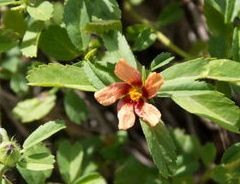Prickly Fanpetals
(Sida dregei)

Description
Sida is a genus of flowering plants in the mallow family, Malvaceae. They are distributed in tropical and subtropical regions worldwide, especially in the Americas. Plants of the genus may be known generally as fanpetals or sidas. These are annual or perennial herbs or shrubs growing up to 2m tall (6 feet). Most species have hairy herbage. The leaf blades are usually unlobed with serrated edges, but may be divided into lobes. They are borne on petioles and have stipules. Flowers are solitary or arranged in inflorescences of various forms. Each has five hairy sepals and five petals in shades of yellow, orange, or white. There are many stamens and a style divided into several branches. The fruit is a disc-shaped schizocarp up to 2 cm (3/4 inch) wide which is divided into five to 12 sections, each containing one seed. The pollens are spherical in shape. Many Sida are attractive to butterflies and moths. Arrowleaf sida (Sida rhombifolia), for example, is a larval host for the Tropical Checkered Skipper (Pyrgus oileus). The Sida golden mosaic virus and Sida golden yellow vein virus have been first isolated from Sida species; the former specifically from Sida santaremensis. The genus name Sida is from the Greek for "pomegranate or water lily". Carl Linnaeus adopted the name from the writings of Theophrastus. Sida has historically been a wastebasket taxon, including many plants that simply did not fit into other genera of the Malvaceae. Species have been continually reclassified. The circumscription of Sida is still unclear, with no real agreement regarding how many species belong there. Over 1000 names have been placed in the genus, and many authorities accept about 150 to 250 valid names today. Some sources accept as few as 98 species. There are many plants recognized as Sida that have not yet been described to science.
Taxonomic tree:







